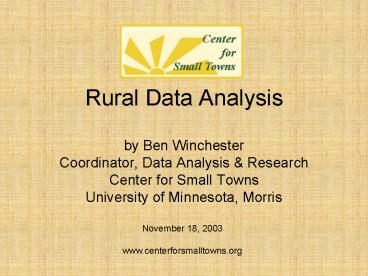Rural Data Analysis PowerPoint PPT Presentation
1 / 26
Title: Rural Data Analysis
1
Rural Data Analysis
- by Ben Winchester
- Coordinator, Data Analysis Research
- Center for Small Towns
- University of Minnesota, Morris
November 18, 2003 www.centerforsmalltowns.org
2
- 853 Cities in 2000
3
Number and Population of Cities by Size in
Minnesota, 2000
Ratio Fact For each city of more than 25,000
persons, there are 22 under 5,000
4
Cities Gaining and Losing Population in 2000 by
Size in Minnesota
5
Population, 2000 Minnesota 80 City 19
Township West Central Minnesota 55 City 45
Township North West Minnesota 44 City 56
Township
6
Population Change 1990 - 2000
7
The largest predictor of growth between 1990 and
2000 is the presence of water. Recreation is the
latest boon for rural Minnesota.
8
- City of Morris
- 5,068 according to 2000 Census
- 5,173 Corrected Figure (misplaced in Baker
Township)
9
Minor Civil Divisions for Stevens
County, Minnesota
10
Traditional maps have focused on the COUNTY level
of analysis.
11
- At the level of
- MINOR CIVIL DIVISIONS,
- the variation within the county
- now becomes apparent.
- Minor Civil Divisions include
- Cities (853)
- Townships (1794)
- Unorganized Territories
12
(No Transcript)
13
Becker Clay Douglas Grant Otter
Tail Pope Stevens Traverse Wilkin
Percent Change 1990-2000 for West Central
Minnesota
14
Cohort-Component Method
- In the cohort-component method, the components of
population change (fertility, mortality, and net
migration) are projected separately for each
birth cohort (persons born in a given year). - In 2000, we expect the 11-20 age to be the the
0-10 age of 2000 plus births, minus deaths /-
migration. - Varies depending on death rates and migration
15
Actual 2000 population vs. 1990 predicted
population of age category West Central Minnesota
16
(No Transcript)
17
(No Transcript)
18
The ABCs of Minnesota Small Towns
19
Data Sources
- U.S. Census Bureau www.factfinder.census.gov
- Bureau of Economic Analysis www.bea.gov
- Minnesota Workforce Center www.mnwfc.org
20
Economic Analysis - Location Quotients
- A location quotient examine the strength of an
industrys concentration in an area - relative to the another area such as the county
in relation to the state. This is a useful tool
to determine key industries in the region. - Data you need
- the county employment by industry and total
employment - the state employment by industry and total
employment - The Equation
- Industrys local employment
- Total local employment
- Share of Employment ----------------------------
------------------- - Industrys state employment
- Total state employment
21
Calculate the Location Quotients
- http//www.bea.gov/bea/regional/statelocal.htm
- Using the data handed out, break into small
groups to calculate the LQ for each major
industry in each year for Stevens County.
22
Location Quotient Interpretations
- A LQgt1 implies the industry is producing more
than is consumed locally. - A LQlt1 indicates residents and businesses
purchase outside the area. - Not all LQgt1 indicate a competitive industry
(government in Stevens County).
23
Location Quotient Change
- change Most recent year LQ - 1 x 100
Base year LQ - Group the industries into four categories
- Large LQ that is declining
- Large LQ that is increasing
- Small LQ that is declining
- Small LQ that is increasing
- Next, discuss an economic development approach
for each category.
24
(No Transcript)
25
Economic Analysis Resources
- Understanding Your Industries (HHH at U of M)
- http//www.hhh.umn.edu/centers/slp/projects/edweb/
uyihom.htm - Understand Your Local Economy Penn State
- http//cecd.aers.psu.edu/using_employment_data_to_
better.htm - Community Economic Development Toolbox CaRDI
(Cornell) - http//www.cardi.cornell.edu/cd-toolbox/index.htm
26
Another Resource
- RRD 141 Community Economic Analysis A How To
Manual - Hustedde, R. J., R. Shaffer, and G. Pulver.
Revised 1993. Community Economic Analysis A How
To Manual. (RRD141). Ames, IA North Central
Regional Center for Rural Development. ISBN
0-936913-06-1. Library of Congress Catalog Card
Number 93-86303. - This manual is intended for the individual
interested in the analysis of a community's
economy. It is designed to assist individuals who
need to bring information to a group of citizens
or decision makers concerned with the economic
future of a community. The manual addresses
nonlocal markets linkage, strategies for economic
development, multipliers, assessing the size and
shape of a community's trade area, keeping local
dollars in the community, measuring the
efficiency of local firms, and other strategies.

